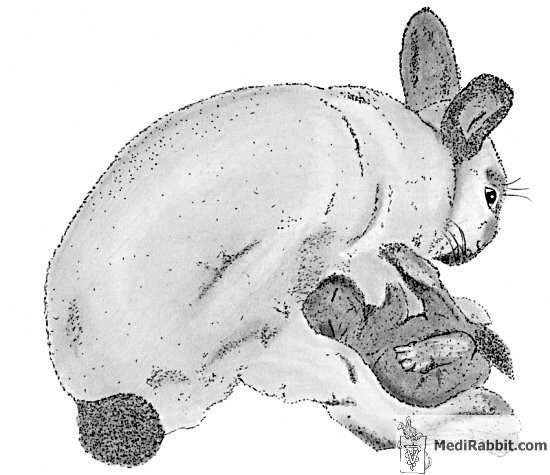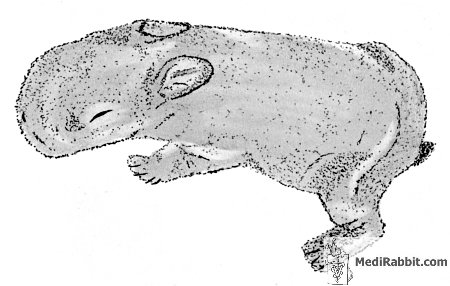Feeding time
Esther van Praag, Ph.D.
|
Rabbit does do not feed their newborn rabbits
often. They come to the nest only once or twice a day. Feeding time is short
a few minutes at most. The portion of milk taken in by healthy newborn is
sufficient for the next 24 hours. The rest of the day, the newborn stay deep
in the nest, and keep warm by cuddling together. After about 22 hours, they
become active and will move together to the surface of the nest. The doe stays in the vicinity of the nest, but will
enter it during feeding time. This does not relate to a lack of maternal
instinct, but this way she avoids attracting the attention to her nest and
avoids signals for carnivorous or prey animals. After carefully checking the
environment, she will enter the nest carefully and place herself over her
offspring, to allow them to feed.
Illustration:
property of MediRabbit.com, after a picture from Karen Comish Week old rabbit drinking milk During the feeding session, the suckling rabbits
attach within 3 to 9 seconds to a nipple, successfully. During the feeding
time, the kittens change place and nipple at intervals of about 1 minute.
This remains unchanged till they reach the age of 15 to 20 days old, when
attachment to nipple covered with saliva was more rapid, in comparison to
those without saliva. After 3 to 5 minutes, the doe leaves the nest. The
kittens will urinate, then burry again together in the nest for 22 hours.
|
|||||||||||||||||||||||||||||||||||||||||||||||||||||||||||||||||||||||||||||||||||||||||||||||||||||||||||||||||||
|
Chemical
composition of rabbit’s milk (after Coates et al., 1964. Brit J. Nutr, 18, 583-586):
Vitamin
content (mg/ml) of rabbit’s milk at different stages of lactation
|
|||||||||||||||||||||||||||||||||||||||||||||||||||||||||||||||||||||||||||||||||||||||||||||||||||||||||||||||||||
|
Between the age of 10 and 15 days, kittens start to
nibble solid food, e.g. pellets, and/or hay more and more, and in bigger
quantity. This does not mean that the newborn can be weaned yet. Indeed, the maturation of gastro-intestinal system
is not yet finished. During the first 3 weeks of the life of newborn rabbits,
the digestive tract remains sterile (devoid of intestinal bacterial flora).
This is unique in the animal world. The absorbed milk has a pH ranging
from 5 to 6.5 that would allow bacterial survival as well as growth and
colonization of the intestine and cecum. Rabbit milk contains a particular
fatty acid with antibacterial properties that prevents the survival of
bacteria in the GI tract. This molecule is sometimes referred to as
"milk oil", and its production needs two parameters, milk of the mother
and stomach of the suckling, to become active and hinder the development of
bacteria. |
Illustration: property of MediRabbit.com, after a picture from Karen Comish Newborn rabbit aged one day |
||||||||||||||||||||||||||||||||||||||||||||||||||||||||||||||||||||||||||||||||||||||||||||||||||||||||||||||||||
|
Passed that age, young rabbits
have become strong, curious, leaves the nest, and start to nibble food
that they find on their way. Up to the 6th week of his life, a young rabbit
will gradually decrease his milk intake. As a consequence, the concentration
of milk oil in the stomach will decrease, and the pH of the stomach
drops from about 5-6 to 1-2. Microorganisms that are ingested will survive
the stomach passage, and start to grow/colonize rapidly in the cecum, and the
different portions of the intestine. If the right bacteria are present,
fermentation can start in the cecum. This last phase is very important and critical.
Indeed, microorganisms that develop inside the GI tract depend on the type of
diet, hay, stress, etc., and it easily happens that pathogen bacteria like
Clostridium sp. colonize the sterile digestive tract. This leads to severe
diarrhea and (fatal) enteric trouble. It is therefore important to keep the newborn
rabbit with the nursing doe up to the age of 8 weeks, and not separate
them earlier at 6 weeks or even younger. Once the complex microbial flora has
colonized the GI tract, it will help prevent the development of pathogen
bacteria. |
|||||||||||||||||||||||||||||||||||||||||||||||||||||||||||||||||||||||||||||||||||||||||||||||||||||||||||||||||||
|
Acknowledgements Many
thanks to Karen Comish and Linda Baley for the
permission to use their material. More information Coates ME, Gregory ME, Thompson SY. The composition
of rabbit’s milk. Br J Nutr. 1964;18:583-6. Harcourt-Brown F. Textbok of Rabbit Medicine. Butterworth Heinemann,
Oxford, 2002, p 55-56. |
|||||||||||||||||||||||||||||||||||||||||||||||||||||||||||||||||||||||||||||||||||||||||||||||||||||||||||||||||||
e-mail: info@medirabbit.com




